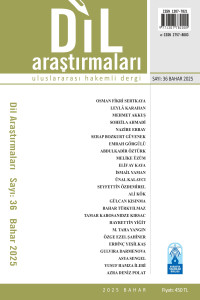Öz
This article reviews the theoretical approaches to ellipsis, specifically focusing on elided noun phrases in Turkish. We first distinguish ellipsis from similar linguistic phenomena, such as gapping and stripping, to clarify its unique characteristics. Following these particular features, we investigate both non-structural and structural approaches to ellipsis, examining their implications and limitations in the context of Turkish NPs. While the non-structural approach and the null-form approach with the structural perspective focus primarily on how ellipsis operates within grammatical forms, we find that they are inadequate to explain certain mismatches or to determine the syntactic restrictions of noun phrase ellipsis in Turkish. In contrast, the phonological-form deletion approach offers a more comprehensive explanation by emphasizing the phrasal heads, providing a syntactic and derivational account of ellipsis, but there are still some patterns in Turkish NPs that require further explanation within the phonological-form deletion framework.
Anahtar Kelimeler
noun phrase ellipsis NP ellipsis Turkish noun phrase Turkish NP ellipsis structural approach to ellipsis non-structural approach to ellipsis
Kaynakça
- AELBRECHT, Lobke (2010). The syntactic licensing of ellipsis. John Benjamins.
- BUSQUEST, Joan (2006). “Stripping vs. VP-Ellipsis in Catalan: What is deleted and when?”. Probus, 18/2: 159-187.
- CHOMSKY, Noam (2001). “Derivation by phase”. Ken hale: A life in language (Edt. Micheal Kenstowicz). MIT Press, 1-52.
- CITKO, Barbara (2014). Phase theory: an introduction. Cambridge University Press.
- CULICOVER, Peter; JACKENDOFF, Ray (2005). Simpler syntax. OUP.
- GALLEGO, Ángel (2009). Ellipsis by phase. Ms Universistat Autònoma de Barcelona.
- GENGEL, Kirsten (2007). Focus and ellipsis: A generative analysis of pseudogapping and other elliptical structures. University of Stuttgart.
- HERNANDEZ, Ana Carrera. (2007). “Gapping as a syntactic dependecy”. Lingua, 117/12: 2106-2133.
- JOHNSON, Kyle (2009). “Gapping is not (VP-) ellipsis”. Linguistic Inquiry, 40/2: 289-328.
- LOBECK, Anne (1995). Ellipsis: functional heads, licensing and identification. OUP.
- MERCHANT, Jason (2001). The syntax of silence. Sluicing, islands and the theory of ellipsis. OUP.
- MERCHANT, Jason (2004). “Fragments and ellipsis”. Linguistics and philosophy, 27: 661-738.
- WINKLER, Susanne. (2005). Ellipsis and focus in generative grammar. Mouton de Gruyter.
- WU, Danfeng (2022). “Island violations in stripping constructions”. Glossa, 7/1: 1-12.
- WURMBRAND, Susi (2017). “Stripping and topless complements”. Linguistic Inquiry, 40/2: 341-366.
Öz
Bu araştırma Türkçedeki eksiltilmiş ad öbeklerine odaklanarak eksiltmeye yönelik alanyazındaki kuramsal yaklaşımları değerlendirmektedir. Bu yönde ilk olarak eksiltmeyi dilsel birim eksikliğine neden olan boşaltma ve soyma/sıyırma kavramlarından ayırarak kendine özgü özellikleri ortaya koyulmaktadır. Bu özellikler doğrultusunda, eksiltme için hem yapısal hem de yapısal olmayan kuramsal yaklaşımlar sırasıyla ele alınarak Türkçe ad öbekleri bağlamında değerlendirilmektedir. Yapısal olmayan yaklaşım ve yapısal bakış açısı altındaki sıfır-biçim görüşü temelde eksiltilerin dilbilgisel olan yapılar içinde nasıl işlediğine odaklanmaktadır. Bu yaklaşımların belirli biçim-anlam uyumsuzluklarını açıklama ve Türkçe ad öbeklerinin eksiltmelerinin sözdizimsel kısıtlarını belirleme noktasında yetersiz kaldığı görülmektedir. Bunun aksine, sesel-biçim silme yaklaşımı öbeksel başlar kapsamında eksiltme işleminin sözdizimsel ve türetimsel sürecine yönelik daha kapsamlı bir açıklama sunmaktadır. Buna karşın, bu yaklaşım çerçevesinde açıklama gerektiren belirli Türkçe ad öbeği eksiltme örüntüleri söz konusudur.
Anahtar Kelimeler
ad öbeği eksiltme AÖ eksiltme Türkçe ad öbeği Türkçe AÖ eksiltme eksiltmeye yapısal yaklaşım eksiltmeye yapısal olmayan yaklaşım
Kaynakça
- AELBRECHT, Lobke (2010). The syntactic licensing of ellipsis. John Benjamins.
- BUSQUEST, Joan (2006). “Stripping vs. VP-Ellipsis in Catalan: What is deleted and when?”. Probus, 18/2: 159-187.
- CHOMSKY, Noam (2001). “Derivation by phase”. Ken hale: A life in language (Edt. Micheal Kenstowicz). MIT Press, 1-52.
- CITKO, Barbara (2014). Phase theory: an introduction. Cambridge University Press.
- CULICOVER, Peter; JACKENDOFF, Ray (2005). Simpler syntax. OUP.
- GALLEGO, Ángel (2009). Ellipsis by phase. Ms Universistat Autònoma de Barcelona.
- GENGEL, Kirsten (2007). Focus and ellipsis: A generative analysis of pseudogapping and other elliptical structures. University of Stuttgart.
- HERNANDEZ, Ana Carrera. (2007). “Gapping as a syntactic dependecy”. Lingua, 117/12: 2106-2133.
- JOHNSON, Kyle (2009). “Gapping is not (VP-) ellipsis”. Linguistic Inquiry, 40/2: 289-328.
- LOBECK, Anne (1995). Ellipsis: functional heads, licensing and identification. OUP.
- MERCHANT, Jason (2001). The syntax of silence. Sluicing, islands and the theory of ellipsis. OUP.
- MERCHANT, Jason (2004). “Fragments and ellipsis”. Linguistics and philosophy, 27: 661-738.
- WINKLER, Susanne. (2005). Ellipsis and focus in generative grammar. Mouton de Gruyter.
- WU, Danfeng (2022). “Island violations in stripping constructions”. Glossa, 7/1: 1-12.
- WURMBRAND, Susi (2017). “Stripping and topless complements”. Linguistic Inquiry, 40/2: 341-366.
Ayrıntılar
| Birincil Dil | İngilizce |
|---|---|
| Konular | Dilsel Yapılar (Fonoloji, Morfoloji ve Sözdizimi dahil) |
| Bölüm | Makaleler |
| Yazarlar | |
| Erken Görünüm Tarihi | 8 Mayıs 2025 |
| Yayımlanma Tarihi | 12 Mayıs 2025 |
| Gönderilme Tarihi | 22 Ekim 2024 |
| Kabul Tarihi | 27 Ocak 2025 |
| Yayımlandığı Sayı | Yıl 2025 Cilt: 19 Sayı: 36 |


